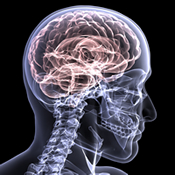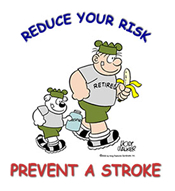General Stroke Information: About Stroke

It is important to know about stroke when caring for your loved one. To be the best caregiver you can, you need to take care of yourself. Learn about the risks for stroke and how to prevent one. You and your loved one can both benefit from this information.
What is a Stroke?
A stroke happens when the brain does not get the oxygen it needs. This causes brain cells to die. The result can be loss of memory, speech and/or movement.
What Do You Need to Know?
How the brain is affected depends on where the stroke occurs. It also depends on how much damage happens. The longer the brain goes without oxygen, the more damage there is.
The two types of stroke are:
- Ischemic (is-KEM-ik) – A stroke caused by a clot blocking a blood vessel to the brain. This prevents the brain from getting the oxygen it needs. It is the most common type of stroke.
- Hemorrhagic (hem-o-RAJ-ik) – A stroke caused when a blood vessel to the brain bursts. This causes bleeding within the brain.
What Are the Warning Signs of Stroke?
Stroke symptoms happen very fast. Call 9-1-1 immediately if you or someone you know has any of the following signs or symptoms.
The most common signs of stroke are sudden. This can include:
- Numbness or weakness of face, arm or leg (mainly on one side)
- Trouble seeing in one or both eyes
- Trouble walking, dizziness or loss of balance
- Confusion or trouble talking or understanding speech
- Bad headache with no known cause
These symptoms may last more than a few minutes. They may start, briefly go away, and then return. Remember, a stroke is a Medical Emergency. Every minute counts.
RED FLAG: Spot a Stroke F.A.S.T.
|
What Risk Factors for Stroke Are Out of Your Control?
Age – The risk of stroke increases with age. It doubles each decade after 55 years of age. Strokes are most common in the older population. However, a person can have a stroke at any age.
Gender – Stroke is more common in men than women. Men are more likely to have strokes at a younger age. Women are more likely than men to die from a stroke.
Race – African Americans are at a higher risk for strokes than Caucasians. This is due to their increased risk of hypertension, diabetes and obesity.
Family history – Stroke is more common if a close family member has had a stroke. A family history of transient ischemic attack (TIA) or heart attack also increases your risk.
What Diseases or Conditions Increase Your Risk of Stroke?
Previous stroke or Transient Ischemic Attack (TIA) – If you have a history of stroke, your risk for another one is much higher. A history of a TIA also raises your risk of stroke. A TIA produces stroke-like symptoms. It does not result in lasting damage. A TIA is often referred to as a “mini stroke.” It is a warning sign that the risk of stroke is high.
Hypertension (High Blood Pressure) – This is the most important risk factor for stroke. It is known as the “silent killer” because there are often no symptoms. Hypertension causes the heart to work harder. This can damage the heart and blood vessels, leading to stroke. Have your blood pressure checked on a regular basis. Hypertension can be controlled by medicine and lifestyle changes, like diet and exercise.
Heart Disease – Heart disease consists of different conditions affecting the heart. These conditions include coronary artery disease (CAD) and arrhythmias (abnormal heart rhythms). When the heart is not working like it should, the risk of blood clots increases. This can lead to a stroke. Heart disease can be managed with medicine and lifestyle changes, like diet and exercise.
High Blood Cholesterol – This increases your risk of having a stroke. Cholesterol is a waxy substance produced in the body. It can stick to the walls of your arteries, leading to heart disease and stroke. Often, high cholesterol can be controlled by diet and exercise. Your healthcare team may also prescribe medicine to lower your cholesterol.
Diabetes Mellitus – Diabetes mellitus greatly raises the risk of stroke. Diabetes is a problem with how the body uses glucose (sugar) for energy. High blood sugar levels can damage blood vessels. This can lead to stroke. Diabetes is treatable. It should be monitored closely and managed by your healthcare provider.
What Lifestyle Choices Increase Your Risk of Stroke?
Eating an Unhealthy Diet – This can lead to many health problems. Diets high in saturated fats, trans fats and cholesterol increase your risk of high cholesterol and obesity. Too much salt intake can raise your blood pressure. Choose a healthy diet high in fruits and vegetables. This can help lower your risk of stroke. Learn more about healthy eating.
Physical Inactivity – Physical inactivity can increase your risk for heart disease and stroke. Getting regular exercise has many benefits. It can help manage your weight and lower your blood pressure. It can also prevent or control diabetes. Try to do at least 30 minutes of moderate exercise most days of the week. Learn more about exercise after stroke.
Obesity – Obesity is a major risk factor for heart disease. It also increases your risk of hypertension, high cholesterol, diabetes and stroke. Eat a healthy diet and exercise regularly to lose weight and lower your risks.
Cigarette smoking – This is a major risk factor for stroke. Cigarette smoke lowers the amount of oxygen in your blood. Smoking makes the blood thicker. This makes it more likely to form a clot. For women, some birth control pills combined with smoking greatly increases the risk of strokes. If you smoke, it is important to quit. Talk to your provider about medicines and programs that can help you stop smoking. For all ages, quitting smoking lowers the risks of health conditions like heart disease and stroke.
What Can You Do to Lower Your Risks?
First, know what your risks are – Start by getting a complete medical work-up or “physical”. Your healthcare team will ask you questions about your medical history. They will check your blood pressure. Blood work and other tests will also be done.
Get regular medical check-ups – Make sure to get checked by your healthcare provider at least once a year. If you have any medical conditions, you will need more frequent check-ups. Be sure to take your medicines as prescribed.
Follow a healthy lifestyle – Eat a healthy diet, low in salt and fat. Exercise regularly. If you smoke, stop. Only drink alcohol in moderation.
Lower your stress level – People under stress are more likely to engage in an unhealthy lifestyle. This increases the risk of high blood pressure and stroke. Take note of what is causing your stress. For some people, meditation or prayer helps to lower stress levels. Exercise may also help. Find what works for you. Take time for yourself and do something you enjoy.
Ask your healthcare team about taking aspirin** – Some people can benefit from a daily dose of aspirin. Aspirin helps to thin the blood and help prevent blood clots. Talk to your healthcare team about whether taking aspirin is right for you.
Remember
- Stroke is a medical emergency. Call 9-1-1 immediately if you or someone you know is having any symptoms.
- Hypertension is the leading risk factor for stroke. Have your blood pressure checked regularly. Take medicines as prescribed.
- Know your risk factors for stroke so that you can make changes. If you smoke, quit. Exercise more and eat healthier.
Stroke Risk Factor and Prevention Resources from the "Sarge" Project 
In 2005, researchers from the VA Rehabilitation Outcomes Research Center developed a series of stroke risk factor and prevention materials for a project titled "Disseminating Stroke Prevention Materials to Veterans." Thanks to the support of Beetle Bailey cartoonist Mort Walker, this project affectionately become known as "The Sarge Project." Mr. Walker, himself a Veteran, genererously donated custom images of his comic strip character Sergeant 1st Class Orville P. Snorkel. Since his introduction in 1951, Sarge has been known for his short-temper, portly build, and poor eating habits. He was a great character to help illustrate some of the risk factors for stroke.
American Stroke Association (ASA), "Let's Talk About..."
- Risk Factors for Stroke
- High Blood Pressure and Stroke
- Stroke, TIA and Warning Signs
- Lifestyle Changes to Prevent Stroke
- Ischemic Strokes and Their Causes
National Stroke Association (NSA)
Additional Documents
- Cholesterol Bookmark (2 per page)
- What do my Cholesterol Numbers Mean?
- Hypertension Bookmark (2 per page)
- Stroke Warning Signs Bookmark (2 per page)
- Stroke Risk Checklist
- Blood Pressure/Stroke Risk Flyer
- Stroke Heroes Act F.A.S.T. Brochure
Other Resources 
Additional credible resources on this topic can be found here. Website pages may change or update, therefore if a link does not work, you may also try to type the information into your internet search bar. This Resource List will be updated frequently.
|
*Link Disclaimer: Links to information and Web sites outside of the Department of Veterans Affairs do not indicate an endorsement of products or services offered by the sites. In addition, these sites may have privacy and security policies that are inconsistent with those of VA. |
References: United States Department of Veterans Affairs. (2008). VA HSR&D Stroke QUERI. Retrieved November 6, 2008, from: http://www.queri.research.va.gov/str/; United States Department of Veterans Affairs. (2008). MyHealtheVet. Retrieved October 10, 2008, from: http://www.myhealth.va.gov/; National Stroke Association. (2008). Retrieved August 26, 2008, from: http://www.stroke.org/*; American Stroke Association. (2008). Learn about Stroke. Retrieved August 26, 2008, from: http://www.strokeassociation.org/presenter.jhtml?identifier=3030387*; U.S. Department of Health and Human Services. (2008). Womenshealth.gov. Retrieved October 22, 2008, from: http://www.womenshealth.gov/*; National Diabetes Information Clearinghouse. (2008). Retrieved October 22, 2008, from: https://www.niddk.nih.gov/health-information/diabetes*; Carelinks.net. (n.d.). STROKE; Remember the 1st three letters: S.T.R. Retrieved January 16, 2009, from: http://carelinks.net/files/stroke.pdf*
These materials were created for the project:
Web-Based Informational Materials for Caregivers of Veterans Post-Stroke
Project Number SDP 06-327 funded by VA HSR&D Quality Enhancement Research Initiative (QUERI)




















